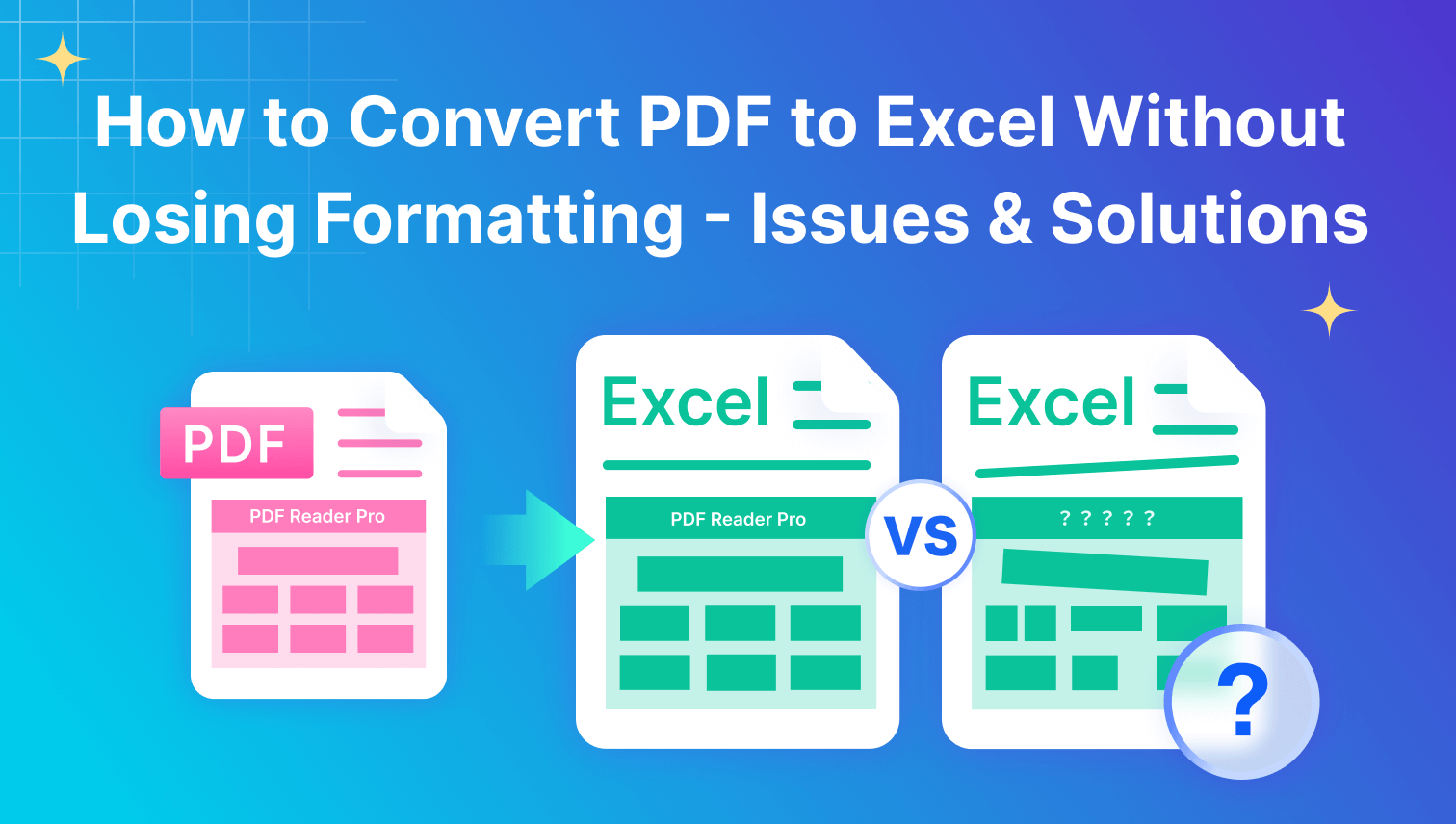
Due to the unique characteristics of the PDF files and the technical complexity of conversion tools, data or formatting often gets wrong when exported to .xls, .xlsx, or Google Sheets. It makes the data unusable and low-efficient.
In this article, we’ll explore the most common errors and issues seen during PDF to Excel conversion, dig into the technical causes behind them, and finally, provide the solution to convert PDF to Excel without losing formatting.
Common Formatting Issues After Converting PDF to Excel
During conversion, kinds of structural and content-related issues may occur. These can be classified as follows:

Technical Causes for Converting PDF to Excel Problems
The Complexity of the PDF Format
-
Lack of structured tagging: Unlike HTML, PDFs don’t use tags like <table>, <tr>, or <td> to describe table structure. This makes interpretation difficult.
-
Different types of PDFs: Native PDFs contain selectable text, while scanned PDFs rely on OCR (optical character recognition). It is hard to extract tables from such image PDF files. Searchable PDFs combine image and hidden text, which some tools fail to recognize and handle properly.
-
Diverse PDF creators: PDFs could be created by different tools. They may use non-standard fonts, vector graphics instead of characters, or include encryption which may make the parsing process complicated.
Table Recognition Challenges
-
Diverse layouts: Data tables vary greatly in design. Some tables are with clear borders, while some are not and even are nested, span multiple pages, or are embedded in complex layouts. Traditional rule-based detection struggles with this variety.
-
Boundary detection: Recognizing where a table starts and ends on a cluttered page can be difficult. PDF to excel converters may include other content into a table or skip parts of the table.
-
Lack of semantic context: Even if cell data is extracted, tools need to understand the logical relationships (e.g., which are headers, which are data rows, how data cells correspond to headers, which logical cells a merged cell covers). PDFs lack this kind of semantic information, so converters must make complex guesses which makes table extraction a big challenge.
Limitations of OCR Technology
-
Accuracy dependency: OCR accuracy varies based on image quality, font style and size, layout complexity, and language settings. Low-resolution scans or complicated documents are especially prone to errors.
-
Non-text elements: Standard OCR tools struggle with checkboxes, signatures, icons, or other non-text visuals commonly found in tables.
Differences in Conversion Algorithms
-
Diverse Technical Routes: Different companies may use different technologies and algorithms to convert PDF to Excel, such as rule-based parsing, heuristic methods, computer vision techniques, and even machine learning (ML) or artificial intelligence (AI) models, causing incompatibility in technologies.
-
Sensitivity to Configuration Parameters: Many conversion tools offer detailed settings for users to get a better conversion result. Settings may include the table extraction mode, manually defining table areas, enabling smart table recognition, or setting the correct OCR language.
Best Practices of Converting PDF to Excel to Avoid Formatting Issues
Even though the underlying challenges are complex, you can significantly improve conversion quality by following these practices:

- Preparation Before Conversion: Whenever possible, use high-quality source PDF files. High-quality images in scanned PDFs have a chance to get accurate conversion like properly aligned pages, clearly scanned pages without noise or interference. Correctly embedded fonts in normal PDFs can also reduce the conversion fail.
- Choosing the Right Conversion Method and Tool: Which is the best converter for you? It depends on many factors like how often you convert, the number of files, and the complexity of the PDF tables. For a few simple tables, most common converters can do a decent job. For complex tables, batch processing, or when high accuracy is critical, consider more powerful desktop software or professional software development kits (SDKs), such as the ComPDFKit Conversion SDK (Try the Online PDF to Excel Demo).
- Set the Right Parameters to Optimize Conversion Accuracy:
- Set OCR Parameters (if applicable): Make sure to enable OCR and choose the OCR language for scanned documents or PDFs with image-based text.
- For Table Conversion: Many advanced tools let users manually specify table areas, choose table extraction modes, or use predefined templates to help identify specific table structures.
- Output Settings: Choose the right options to put your extracted and converted table in Excel sheet. Options may include merging all tables into one single Excel sheet, creating a separate sheet for each table, or each PDF page for a sheet.
- Test and Adjustment: Different PDF documents might need different settings to get a good conversion performance. Adjust and find the best settings for your document.
- Manual Adjustment After Conversion: Even with the best tools and settings, misaligned columns, garbled text, data type errors, and lost or incomplete data may also present. It's highly recommended to manually check and adjust the converted Excel file.
Conclusion
Converting PDF to Excel without losing formatting is challenging. However, you can greatly reduce formatting issues with a right converter, proper settings, manual adjustment, etc.
For developers, using a high-performance SDK like ComPDFKit Conversion SDK can further ensure accuracy and scalability when integrating this functionality into applications.